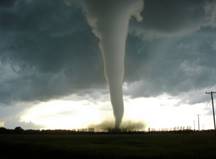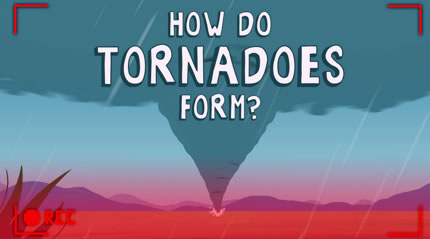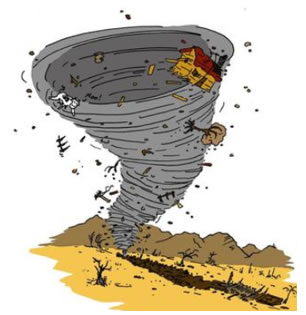Tornado Warning Signs You Need to Know
What Is Tornado Alley?
 Tornado Alley is a region of the United States that is regularly hit with tornados. Tornado Alley covers the Great Plains and is centered on eastern Kansas and Oklahoma and also included parts of the surrounding states, where tornados are most frequent. The city with the most recorded tornados is Oklahoma City, which also has the strongest winds ever recorded (over 316 mph), during a tornado on May 3, 1999. That tornado also holds the record for the most costly damage - over one billion dollars!
Tornado Alley is a region of the United States that is regularly hit with tornados. Tornado Alley covers the Great Plains and is centered on eastern Kansas and Oklahoma and also included parts of the surrounding states, where tornados are most frequent. The city with the most recorded tornados is Oklahoma City, which also has the strongest winds ever recorded (over 316 mph), during a tornado on May 3, 1999. That tornado also holds the record for the most costly damage - over one billion dollars!
If you want to know more about Tornado Alley, take a look at the facts below:
- Tornado Alley is best described as the area where cold dry air, warm dry air and warm moist air clash, making it suitable of thunderstorm and tornado production.
- Tornado Alley is term mostly used by the media to describe a region or area with a frequency of tornados. The National Weather Service and NOAA have never given an official definition to the term nor specified an actual area that is Tornado Alley.
- The gulf coast area has its own Tornado Alley which is often referred to the Dixie Alley. Tornados in this area typically occur in late fall.
- The term Tornado Alley was first used in 1952. The phrase was used as the title of study done on severe weather in parts of Oklahoma and Texas.
- Building codes are often much stricter in areas designated as Tornado Alley in order to help prevent damage to property and loss of life.
- Tornado Alley is the region that is suitable for the production of supercell thunderstorms. Which can typically produce EF-2/F2 or greater tornados.
- Tornado Alley is considered to be located in the Southern Plains area of the United States. Tornados in this area typically occur in late spring.
- The criteria to be in Tornado Alley can vary and is based on the observers representation of what criteria is needed to be met to be in Tornado Alley.
Storm Shelter Supply List: What to Take To Your Shelter
 When it comes to the unpredictable weather in Oklahoma City and Tulsa, OK, it's always best to be prepared. And being prepared isn't just about having a storm shelter, but also ensuring it's well-stocked to keep your family safe and comfortable during a storm. At Ground Zero Shelters, we want to help you ensure that your tornado shelter supplies are comprehensive and adequate, whether you're preparing for a short-term storm or a longer, more severe one.
When it comes to the unpredictable weather in Oklahoma City and Tulsa, OK, it's always best to be prepared. And being prepared isn't just about having a storm shelter, but also ensuring it's well-stocked to keep your family safe and comfortable during a storm. At Ground Zero Shelters, we want to help you ensure that your tornado shelter supplies are comprehensive and adequate, whether you're preparing for a short-term storm or a longer, more severe one.
Prepping Your Shelter: Short-Term Tornado Supplies
Preparation is key when facing any kind of storm, particularly with those as volatile and unpredictable as tornados. To equip your shelter effectively for short-term needs, consider what tornado shelter supplies are fundamental for your safety and comfort. Essential items like non-perishable food and water should be top on your tornado shelter supply list, ensuring you can sustain yourselves even when conditions outside are treacherous. In addition to food and water, other crucial tornado supplies include warm clothing, blankets to combat the cold, and lighting supplies such as flashlights and batteries, guaranteeing visibility even when power fails. A comprehensive first aid kit should also be a priority, preparing you for any injuries that might occur during the storm. However, always remember to personalize your preparations based on your family's specific needs. If you have an infant, including baby supplies like formula and diapers is crucial. Likewise, consider any unique health concerns among family members and stock up on necessary medications and supplies. Ensuring your storm shelter supplies cater to your family's particular needs can make the difference between mere survival and comfort during the ordeal.
Going the Extra Mile: Long-Term Tornado Shelter Supplies
Going the extra mile in tornado preparedness involves thorough planning and equipping your shelter for potentially longer stays. This means, apart from the essentials, your tornado shelter supplies should be sufficient in quantity to sustain your family for an extended period. Carefully consider the amount of non-perishable food and water you'll need, and ensure your tornado shelter supply list includes these items in abundance. However, tornado supplies for long-term preparedness are not just about nourishment and survival. It's also about securing your valuable documents and records. Imagine the upheaval a tornado can cause in Oklahoma City or Tulsa, OK; essential documents like passports, family records, and wills can get lost or destroyed. To prevent such a scenario, ensure you have copies of these important documents stored safely in your shelter. Remember, a well-stocked shelter not only guarantees physical well-being but also provides a sense of security in knowing that your essential records are safeguarded in case of a severe storm.
Keeping Your Tornado Shelter Supply List Updated
Establishing a tornado shelter supply list is only the first step in ensuring your family's safety during a storm. A crucial aspect of maintaining your storm readiness is keeping your tornado supplies updated and ready at a moment's notice. This means regularly checking expiry dates on food, water, and medicines, replacing any borrowed items, and keeping everything neatly organized for easy access. Make it a habit to review your tornado shelter supply list every few months. Seasonal changes may necessitate additional items or the removal of others. You may also need to update supplies to cater to the changing needs of growing children or new family members. Remember, a well-maintained tornado shelter stocked with essential supplies not only ensures your family's safety during a storm but also provides peace of mind throughout tornado season in Oklahoma City and Tulsa, OK. It's not just about knowing what supplies you need for a tornado; it's about ensuring they're always ready when you need them.
Completing Your Tornado Preparedness with a Ground Zero Shelter
We hope this comprehensive guide provides a clear picture of what to take to your storm shelter, from the bare essentials to the extra preparations for longer-term stay. Remember, even a fully prepped backpack can make a significant difference to your safety during a storm. At Ground Zero Shelters, we know that the most crucial part of your tornado shelter supply list is the tornado shelter itself. If you're in Oklahoma City or Tulsa, OK, and you don't yet have a shelter, we invite you to contact us to check out our models and order a custom shelter online. Remember, when it comes to tornado preparedness, we're in this together!
Taking Shelter - Dos and Don'ts

Tornado Shelter Safety in Oklahoma with Ground Zero Shelters
When we think about the fierce tornadoes that frequently strike places like Oklahoma City and Tulsa, the importance of being prepared becomes abundantly clear. The difference between safety and disaster often boils down to the knowledge and decisions of the individuals caught in these storms. Knowing the right dos and don'ts of taking shelter can be the dividing line between relief and tragedy. From having a clear safety plan in place to understanding the essentials of a well-stocked storm shelter, every detail matters. Ground Zero Shelters has you covered with our top-notch above-ground safe rooms and storm shelters.
The Dos of Taking Shelter
When tornadoes threaten, knowing how to respond can be the key to staying safe. Taking shelter isn't just about finding cover; it's about being prepared and knowing what to do before, during, and after the storm hits. Here are essential steps everyone should follow to ensure their safety during these unpredictable events.
- Have a Plan and Stick to it: Every member of your family should be well-versed with the tornado safety protocol. Discuss and decide on a meeting point and ensure everyone, including kids, know the way to the tornado shelter.
- Regular Drills: Practice makes perfect. Conduct regular tornado drills, replicating real-life scenarios. This will instill a sense of preparedness and highlight any weak points in your plan.
- Stock Up: Stock your storm shelter with essentials. These should include a weather radio, flashlights, water, food, and blankets. Every family is unique, so tailor your supplies accordingly.
- Entertainment is Essential: Especially when kids are involved, keeping spirits up and minds occupied is crucial. Pack board games, coloring books, cards, or even a small portable DVD player to pass the time.
- Secure the Shelter: Once everyone is safely inside, ensure the shelter door is tightly fastened. Remember, the wind and pressure during a tornado can be immensely powerful.
The Don'ts of Taking Shelter
In the face of an approaching tornado, not only is it vital to know the right actions to take, but it's equally crucial to be aware of common mistakes to avoid. Even small mistakes can have significant consequences during these powerful storms. These are some of the things you shouldn't do when seeking safety from a tornado.
- Never Assume: Never assume that every family member knows what to do. Communication is key, especially with young ones who might not fully grasp the severity of a tornado.
- Avoid Delay: Time is of the essence when a tornado warning is issued. Do not wait until the storm is close. The faster you take shelter, the safer you'll be.
- Stay Calm and Remain Inside: The roaring sound of a tornado can be terrifying. Yet, it's essential to stay calm. After the tornado passes, there's a brief calm period. Wait a while and ensure the storm has truly passed before stepping out.
Understanding Tornado Threats in Oklahoma
Oklahoma City and Tulsa are no strangers to the raw power of tornadoes. These fierce storms can strike with little warning, leaving devastation in their wake. Given the unpredictability and intensity of these natural disasters, investing in a reliable storm shelter is not just a good idea, but it's essential. Ground Zero Shelters stands as a beacon for those seeking robust and trustworthy protection against tornadoes. We've studied these storms in-depth, and our shelters are designed to offer the maximum safety possible.
Prioritize Your Safety with Ground Zero Shelters
Your family's safety should never be compromised. While some might consider temporary or makeshift solutions, these can prove to be inadequate in the face of a full-blown tornado. Relying on areas like an outdoor shelter can be risky, exposing you to the storm's dangerous elements. Ground Zero Shelters brings you a solution built on trust and experience. Having protected countless families across Oklahoma, we have a proven track record. When you choose us, you're not just getting a shelter, but you're gaining peace of mind.
Navigating the Aftermath with Confidence
Tornadoes can leave a trail of destruction that feels overwhelming. Homes might be damaged, and landscapes changed, but it's essential to remember that with the right resources and support, recovery is possible. Ground Zero Shelters not only offer protection during the storm but also guidance in its aftermath. Our commitment to your safety extends beyond the storm, ensuring you have the resources and knowledge to rebuild and recover.
Take Action Now
Stay safe, Oklahoma residents. If you don't have a tornado shelter yet or are considering an upgrade, now is the time. Contact us today. Don't wait for the next tornado warning to realize the importance of taking shelter. Be proactive, be safe.
What Causes a Tornado to Start
With wind speeds that can reach more than 300 mph, tornados are one of the most destructive natural disasters on the planet. Although scientists don't entirely understand how they are formed, they do have a good idea about the conditions that cause tornados to develop in the first place.
Tornados have touched down on all continents except Antarctica, but certain locations on Earth are more likely to experience tornados than others. Most tornados occur in Tornado Alley— the tornado-prone region of the United States, that spans from Texas to Kansas as well as the states in the Great Plains region.
This area often has the three things necessary for tornados to form:
- A lot of warm, moist air close to the ground.
- Atmospheric instability, a condition that promotes the vertical movement of air.
- Clashing air fronts that propel moist air upward.
 In areas where tornados can occur, warm, moist, low-elevation wind collides with cool, dry, higher-elevation wind. This unstable interaction causes the warm air front to quickly rise and cool air front to fall, which leads to the formation of a supercell, a type of thunderstorm with a long-lived, swirling updraft of air.
In areas where tornados can occur, warm, moist, low-elevation wind collides with cool, dry, higher-elevation wind. This unstable interaction causes the warm air front to quickly rise and cool air front to fall, which leads to the formation of a supercell, a type of thunderstorm with a long-lived, swirling updraft of air.
However, not all supercells result in tornados.
Scientists believe that if the two opposing winds move at different speeds, the air in between them will rotate on a horizontal axis. If one end of the horizontal air column gets caught in the supercell's updraft, it will tilt vertically, forming a funnel cloud.
The continuous upward energy of the supercell elongates the funnel cloud, and causes its spin to tighten and speed up (similar to the way ice skaters spin faster when their arms are pulled close to their bodies).
Rain and hail from the thunderstorm push down on the tail of the funnel. When the bottom of the funnel cloud finally touches the ground, it becomes a tornado.
Don’t wait any longer and keep your family safe by ordering a storm shelter today!
What to Look for When a Tornado is Approaching
 We recently learned how tornados are formed, but all that knowledge is useless unless you know what to look for. So let’s discuss how to spot a tornado.
We recently learned how tornados are formed, but all that knowledge is useless unless you know what to look for. So let’s discuss how to spot a tornado.
Sign #1 - Severe thunderstorm tornados are usually accompanied by heavy rain, hail and lightning.
Sign #2 - Rotating wall clouds or funnel clouds originate from the lowering down of the meso-cyclone, almost a certain sign that a tornado is developing or approaching.
Sign #3 - Green skies. In the middle of a thunderstorm, if you see that the dark sky is turning green, it could be a sign of tornado formation. Green-tinted storm clouds are the result of dense moisture in the atmosphere reflecting green light.
Sign #4 - A tornado watch is issued. This happens when conditions are just right for a tornado to form. Learn what to do when a tornado watch is issued.
Sign #5 - Flying debris in the air. A tornado may pick up debris on its way to your neighborhood.
Sign #6 – There is a calm period after heavy rain and / or hail.
There are numerous signs, and you may not see all of them, but the best bet is that you will encounter a few of them before coming in contact with a tornado. There are also several safety rules that you should follow. Below are the do’s, don’ts and the never’s of tornado safety survival.
The Do’s of Tornado Safety Survival:
- Go to the basement or a customized storm shelter. If you don’t have any of these, you can seek shelter in a small interior ground floor room like a bathroom, closet or hallway.
- Stay away from windows, outside walls and doors.
- If possible, find shelter in another building if you are in a gymnasium, church or auditorium. If you are in one of these buildings and cannot leave, take cover under a sturdy structure such as a table or desk.
- Get as close to the ground as possible, protect your head and watch for flying debris.
The Don'ts of Tornado Safety Survival:
- Take shelter under a bridge or overpass
- Remain in a vehicle or mobile home
- Attempt to “stabilize pressure” by opening windows
- Dive for the southwest corner of your basement
The Never’s of Tornado Safety Survival:
- Attempt to outrun a tornado in a vehicle
- Continue to walk or drive, assuming the tornado won’t strike near you
- Take open shelter close to a hill or lake because “tornados don't hit lakes”
- Attempt to photograph an oncoming tornado
- Chase tornados
How to Stay Safe During Tornado Season
Every year from early spring to mid-summer tornados become a reality in many states. Tornados can occur anywhere and at any time if the conditions are right. But during tornado season, the chances of these storms occurring in Tornado Alley and the Great Plains are the greatest.
On average, 60 people will lose their lives each year. So what can you do to make sure you and your family aren't listed among the casualties the next time a tornado touches down in your neighborhood?
Rule #1 – Get Prepared
You need to invest time and money into a disaster supplies kit and create a family disaster plan.
Rule #2 – Treat All Warnings Seriously
What is a tornado watch, and how is it different from a warning?
A tornado watch defines an area where tornados and other kinds of severe weather are possible in the next few hours. It does not mean tornados will form - just that you need to be alert and prepared to find safe shelter if they do. Find out what to do when a tornado watch is issued.
A tornado warning, issued by the local National Weather Service office, means that a tornado has been spotted, or that Doppler radar indicates a thunderstorm acting in a way which can spawn a tornado. Find out what to do when a tornado warning is issued.
Rule #3 – Buy a Weather Radio
Make sure your weather radio has fresh batteries, and that it is on standby whenever thunderstorms are likely. A good weather radio will activate itself whenever a tornado watch or warning is issued, (and will do the same for any other weather threat or civil emergency). If there are tornados forming in your area, your best defense is having the time to get to safe shelter, and a weather radio will give you this.
Rule #4 – Find Shelter
Make sure you know where safe shelter is, and make sure you know how to get there in a hurry. Finding shelter will be made easier if you are prepared. Most workplaces and schools in a tornado-prone area will have an action plan. If you are at home you should move to a safe location, either one you have prepared in your home, or at a public shelter.
The safety of a home storm shelter will depend on the construction of your house, and whether you have modified it to provide a safe room.
If you are in your vehicle when a tornado strikes you have two choices. If traffic and roads allow, you can drive away from it - if possible take a few moments to assess the risks.
If you can see the tornado, line it up with a fixed point such as a building or a tree. If it moves to the left or right the tornado is not heading toward you; but to be on the safe side, drive away in the opposite direction.
If it doesn't appear to move, but does appear to be growing larger, it is probably coming your way. If you can't drive away from it or find a secure shelter, abandon your car, and lie flat on the lowest ground you can find - a roadside ditch would be a good option. Cars can be death traps, and sheltering under bridges or overpasses is very risky.
So as you can see, it is best to have a plan, and keep your weather radio handy and charged up. If you follow these guidelines, you should stay safe during tornado season.
|
< Previous
<< First |
Go to > 2 3 4 5 6 7 8 |
Next >
Last >> |








